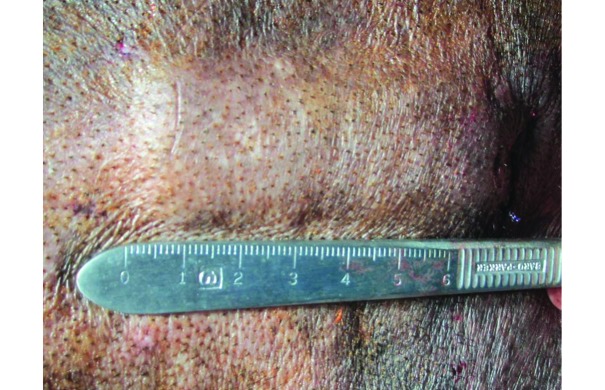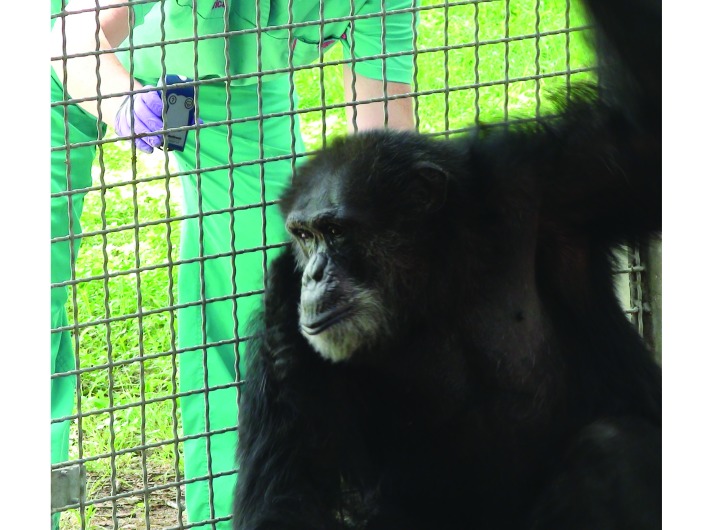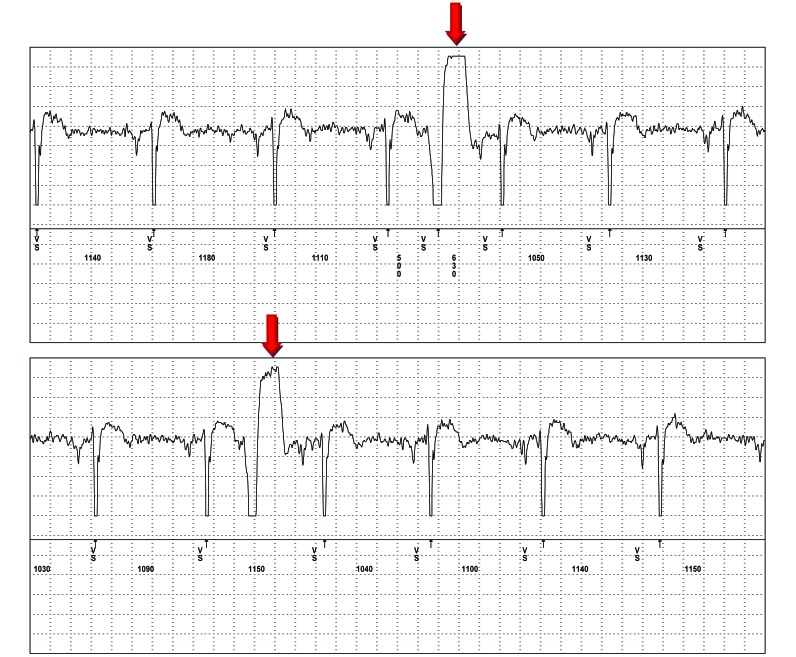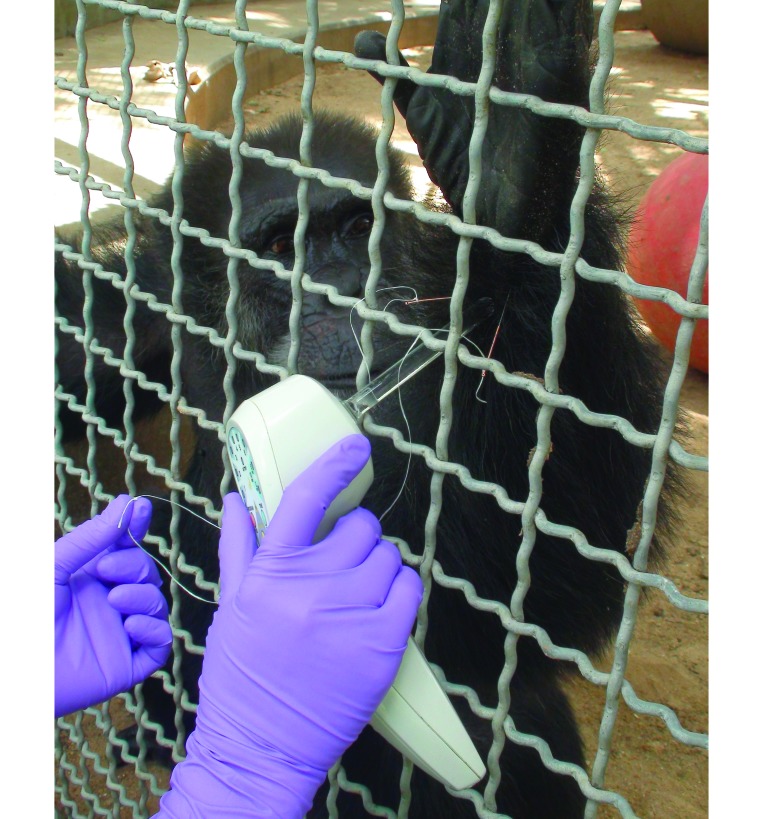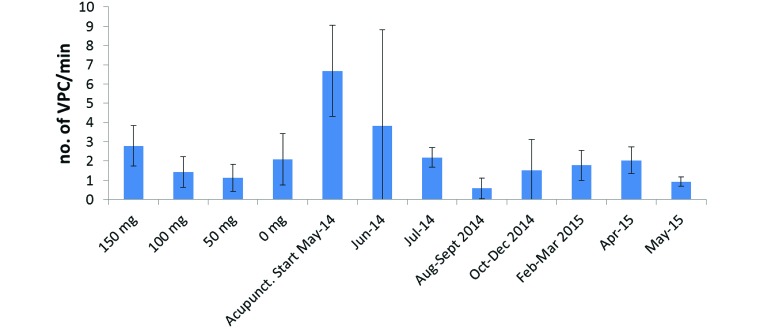Abstract
Cardiovascular disease is a leading cause of death in captive chimpanzees and is often associated with myocardial fibrosis, which increases the risk of cardiac arrhythmias. In this case report, we present a 36-y-old male chimpanzee (Pan troglodytes) diagnosed with frequent ventricular premature complexes (VPC). We placed a subcutaneous implantable loop recorder for continual ECG monitoring to assess his arrhythmias without the confounding effects of anesthetics. During his initial treatment with the antiarrhythmia medication amiodarone, he developed thrombocytopenia, and the drug was discontinued. After reviewing other potential therapies for the treatment of cardiac arrhythmias, we elected to try acupuncture and laser therapy in view of the positive results and the lack of adverse side effects reported in humans. We used 2 well-known cardiac acupuncture sites on the wrist, PC6 (pericardium 6) and HT7 (heart 7), and evaluated the results of the therapy by using the ECG recordings from the implantable loop recorder. Although periodic increases in the animal's excitement level introduced confounding variables that caused some variation in the data, acupuncture and laser therapy appeared to decrease the mean number of VPC/min in this chimpanzee.
Abbreviations: HT7, acupuncture site heart 7; ILR: implantable loop recorder; PC6: acupuncture site pericardium 6; VPC, ventricular premature complexes
Cardiovascular disease is one of the leading causes of death in captive chimpanzees (Pan troglodytes).9,15 This incidence represents a similarity to humans, in whom cardiovascular disease is also the leading cause of death,8 although the pathologic processes differ between these species. Although human heart disease generally results from coronary artery atherosclerosis, heart disease in chimpanzees is associated with a diffuse interstitial myocardial fibrosis;31 however, both processes can be fatal. A survey of 87 deceased adult chimpanzees found evidence of cardiac disease in 68% of the cases, among which it was the primary cause of death in 34%.26 At another NHP facility, 38% (n = 13) of all deaths reported in a 6-y period were associated with sudden cardiac death.14 All of these animals had been diagnosed with various degrees of cardiomyopathy prior to death, and 12 of the 13 cases were diagnosed with interstitial myocardial fibrosis according to histology.14
Myocardial fibrosis is correlated with an increased risk of cardiac arrhythmias2,7 and is a common cause of sudden cardiac death in chimpanzees, occurring much more frequently in male than in female chimps.12,29,31 In chimpanzees, interstitial myocardial fibrosis has a random distribution throughout the myocardium. As the fibrosis progresses, it is thought to disrupt cardiac electrical signals, potentially leading to a fatal arrhythmia that presents as a sudden cardiac death.31 The mechanism underlying interstitial myocardial fibrosis is not entirely understood but might be related to age-associated activation of fibroblasts and diminished reparative stimuli.1 In addition, inflammation might play a role in the development of interstitial myocardial fibrosis, given that cardiac fibrosis and remodeling are common sequelae to inflammation.11 Other factors that increase the risk of developing cardiac arrhythmias in chimpanzees include age (older than 30 y), male sex, and structural heart disease.4,12
Given the high rate of mortality caused by cardiovascular disease in chimpanzees, detecting the disease early and beginning appropriate therapeutics are important. Electrocardiography is a simple diagnostic test that can detect cardiac rhythm abnormalities. However, anesthesia can serve as a confounding variable during ECG analysis of sedated chimpanzees. For the safety of both people and animals during physical examinations, chimpanzees are sedated by using tiletamine–zolazepam; anesthesia is then maintained with isoflurane. These anesthetic agents can cause decreases in heart rate, blood pressure, and cardiac output, as well as respiratory depression.20 In humans, the inhalant agent isoflurane prolongs the QT interval, and this prolonged cardiac repolarization can cause ventricular arrhythmias.28 Given the limited application of tiletamine–zolazepam, which primarily is used as a veterinary drug, no information regarding the association of tiletamine–zolazepam with cardiac arrhythmias in humans is available. However, cardiac arrhythmias are not uncommon in sedated chimpanzees, in which the most common arrhythmia is ventricular premature complexes (VPC).4,27 Although VPC can occur in sedated chimpanzees with no apparent adverse effects, multiform VPC are associated with the highest risk of mortality.4
Acknowledging the confounding effects of anesthesia in evaluation of ECG and cardiac arrhythmias, assessing ECG data from a nonsedated chimpanzee likely would be beneficial. In this report, we present a case in which we subcutaneously implanted a cardiac loop recorder to obtain ECG data longitudinally from a nonsedated chimpanzee. This technique was used successfully previously to investigate cardiac arrhythmias in 4 adult chimpanzees.13 Here we present the ECG findings from a male chimpanzee with cardiac arrhythmia and describe the effects of both antiarrhythmic pharmaceutical agents and the use of integrative medicine in treating the arrhythmia.
Case Report
A 36-y-old male chimpanzee (weight, 58.1 kg) was identified to have frequent VPC during routine physical examination in 2011. Although occasional VPC (that is, fewer than 1 VPC/min) had been observed during previous physical exams, the frequency did not prompt clinical concern until August 2011. This date coincided with this animal's first echocardiogram, which revealed mild prolapse of the mitral and tricuspid valves, with slight mitral valve insufficiency and frequent VPC on ECG (1 to 2 or more VPC/min). He was started on the antiarrhythmic β-blocker sotalol (40 mg PO BID), a class III antiarrhythmic agent.
Follow-up echocardiography in January 2012 revealed continued frequent VPC, which were multifocal with both singlets and couplets (Figure 1). At this time, the animal's medication was switched to amiodarone (100 mg PO BID), another class III antiarrhythmic agent. An echocardiogram in February 2012 again revealed continued frequent VPC, and the amiodarone dose was increased to 150 mg PO BID.
Figure 1.
ECG strip (3-lead) from January 2012, demonstrating couplet VPC (arrows).
Given the severity of the cardiac arrhythmias, we elected to implant a subcutaneous cardiac loop recorder (Reveal, Medtronic, Minneapolis, MN) for ECG monitoring. The goals of implanting this device were 2-fold. First, we wanted to be able to assess the animal's conscious (unsedated) cardiac rhythm, given that anesthetic drugs can elicit VPC. Second, we wanted to monitor the ECG closely, to determine when a dose of antiarrhythmia medication that controlled the VPC was achieved.
However, this chimpanzee developed a rare side effect of amiodarone: he was diagnosed with thrombocytopenia (platelet count, 69 × 103/μL) in 2013. Thrombocytopenia is a documented potential side effect of amiodarone.25,32 In light of the drug-induced thrombocytopenia, we elected to discontinue using amiodarone in this animal. No additional antiarrhythmic agents were administered. After reviewing other potential therapies for the treatment of cardiac arrhythmias, we elected to try acupuncture treatment in light of the positive results and the lack of adverse side effects reported in the literature.
To our knowledge, acupuncture has not been used previously to treat cardiac arrhythmias in NHP. However, evidence in the human literature suggests that acupuncture might be effective in this context. In one report of 98 human patients with VPC, 96.9% of the cases showed significant improvement after acupuncture therapy.6 A review of literature in which acupuncture was used to treat various cardiac arrhythmias disclosed beneficial effects in patients with atrial fibrillation, bradycardia, supraventricular tachycardia, ventricular tachycardia, and asystole.30 We proceeded with acupuncture and low-level laser therapy at 2 well-known cardiac acupuncture sites on the wrist, PC6 (pericardium 6) and HT7 (heart 7) and evaluated the results of this combined therapy by using the ECG data from the implantable loop recorder.
Methods
Animals.
Including the animal whose case we report here, all chimpanzees at the Michale E Keeling Center for Comparative Medicine and Research are maintained in group housing, in accordance with the Animal Welfare Act and the Guide for the Care and Use of Laboratory Animals,10 in a fully AAALAC-accredited facility. Chimpanzees have indoor–outdoor access to large outdoor habitat areas and indoor sheltered dens. The animals are fed a high-fiber commercial diet that contains 20% protein (Chimpanzee Diet 7775, Harlan Teklad, Indianapolis, IN) twice daily. In addition, the chimpanzees receive 4 meals of fresh produce every day. Daily environmental enrichment is provided by using various food puzzle devices, forage such as popcorn and sunflower seeds scattered in the grass of outdoor habitats, manipulable items such cardboard boxes, and rewards during positive reinforcement training.
All chimpanzees receive annual physical examinations, with more frequent examinations as needed according to health status. Physical exams are done under sedation, which is initiated with tiletamine–zolazepam (2 to 4 mg/kg IM) and maintained by using isoflurane (0.5% to 3%) after endotracheal intubation. Animal health is monitored through assessment of CBC, clinical chemistry, tuberculosis tests, electrocardiography (3-lead ECG: ProPaq Encore, Welch Allyn, Beaverton, OR; 12-lead ECG: CardiofaxS model ECG-1250A, Nihon Kohden, Tokyo, Japan; modality chosen depending on risk), abdominal ultrasonography, prostate or vaginal examination, dental prophylaxis, vital signs (blood pressure, body temperature, heart rate, and respiratory rate), and peripheral capillary oxygen saturation (ProPaq Encore, Welch Allyn).
Data collection.
An implantable loop recorder (ILR; Reveal, Medtronic) was used to record ECG activity in our chimpanzee. The device is approximately the size of a computer flash drive (62 mm × 19 mm × 8 mm; 15 g; titanium) and was placed subcutaneously dorsal to the heart, between the shoulder blades (Figure 2). Although the ILR generally is placed ventral to the heart in humans, this chest location is easy for chimpanzees to access, and a previous study has shown that the monitored animal (or another animal living in the same habitat) can remove the device.13 To prevent removal by social conspecifics after implantation of the ILR, the implanted chimpanzee was kept separate from his social group until the surgical incision healed completely. After the incision site healed, he was reunited with his social group.
Figure 2.
Implantable loop recorder placed subcutaneously between shoulder blades.
The ILR we used can be programmed to automatically record the following cardiac arrhythmias, with defined recording parameters set by the user: asystole, bradycardia, ventricular tachycardia, and fast ventricular tachycardia. Although no setting for VPC exists, an available feature enables a patient to use the Reveal System Activator when experiencing symptoms of cardiac arrhythmia. This ‘symptom-recording’ feature collects a 7.5-min ECG, starting 1.5 min prior to initiation of the Reveal System Activator. By using the symptom-recording feature, we were able to collect various ECG recordings over time and during various times of the day. We recorded 1 to 3 of these 7.5-min ECG each week, which typically were collected during the late morning hours (after 1000) or in the afternoon, focusing on time periods when the animals usually are calm. We avoided the early-morning hours associated with increased cleaning activity and meal times, which often cause excitement. We then calculated an average VPC rate given the frequency of VPC in the ECG data so obtained.
The ECG data are stored continually on the ILR until downloaded by using the Reveal System Activator. Data must be downloaded before the memory space is filled, to prevent the loss of previously recorded data. To download the information, the chimpanzee presented his back (where the implant is placed) for approximately 30 s (Figure 3). The stored data then were transferred to a computer, where the recorded ECG were viewed and analyzed (Figure 4).
Figure 3.
Male chimpanzee presenting his back for downloading of ECG data stored on the implantable loop recorder.
Figure 4.
ECG from the implantable loop recorder, demonstrating the presence of VPC (arrows).
Acupuncture and laser therapy.
A certified veterinary medical acupuncturist performed the acupuncture and laser therapies. To this end, positive reinforcement training techniques were used to train the male chimpanzee to present both wrists for treatment. We consider an animal to be trained once they hold in position for 5 consecutive minutes, but ideally the trained behavior is held for 10 min bilaterally. In the current case, 2 training sessions were required for the chimpanzee to reliably cooperate for unilateral wrist presentation. Another 7 training sessions were needed to achieve reliable cooperation for bilateral wrist presentation.
The 2 acupuncture points used were PC6 and HT7. The PC6 site is located proximal to the carpal joint between the tendons of the flexor carpi radialis and the palmaris longus.33 The HT7 site is located on the lateral carpus, lateral to the flexor carpi ulnaris and superficial digital flexor tendons.35 We used sterile, disposable, noncoated, surgical stainless steel hwa-to acupuncture needles (diameter, 0.25 mm; length, 25 mm; Suzhou Medical Instruments, Jiangsu, China). Dental floss was tied around the acupuncture needles to prevent their loss into the animal enclosure should the chimpanzee choose to exit a treatment session early. Acupuncture sessions occurred weekly, with an approximate duration of 10 min on each wrist.
Low-level laser therapy was provided as an adjunct therapy while the acupuncture needles were still in place. The laser device used (MR4 ActiVet, Multi Radiance Medical, Solon, OH) is an FDA-approved class 1M laser. The same sites (PC6 and HT7) were targeted for a duration of 2 min per site bilaterally, by using the laser setting of 1000 Hz (program setting 3). The acupuncture trigger probe set was used in conjunction with the laser therapy to extend the physical length of the laser and permit treatment through the enclosure mesh (Figure 5).
Figure 5.
Adult male chimpanzee receiving acupuncture and laser therapy at acupuncture sites PC6 and HT7.
Statistical analysis.
The number of VPC per minute (mean ± 1 SD) was calculated by using the symptom-recording feature, starting at the time of ILR implantation. The ECG was monitored and the number of VPC was analyzed as occurred during the various treatment modalities, starting with the antiarrhythmic drug amiodarone, tapering off amiodarone, and transitioning to acupuncture and laser therapy. Data were analyzed by using one-way ANOVA (version 23.0, SPSS, IBM, Armonk, NY) to assess differences in VPC between treatments modalities (n = 3 to 23, depending on the modality and month analyzed).
Results
When we began collecting data from the chimpanzee by using the ILR, the mean number of VPC (per minute) was 2.78 (Figure 6). At that time, the chimpanzee was receiving 150 mg amiodarone PO BID. After this initial assessment, we tapered the amiodarone dose because the animal developed thrombocytopenia. The amiodarone dose was decreased to 100 mg BID for 12 d, followed by 50 mg BID for 20 d, and 0 mg for 218 d prior to the initiation of acupuncture therapy. We were concerned that the incidence of VPC might increase during this weaning period, but the frequency actually decreased slightly (albeit nonsignificantly) during this time. During the time when the chimpanzee received no amiodarone, the mean number of VPC was 2.08 per minute (Figure 6).
Figure 6.
The frequency (mean ± 1 SD) of VPC during amiodarone treatment and after acupuncture and laser therapy.
During the month that we initiated acupuncture and laser therapy (May 2014), there was a surprising increase in the number of VPC (mean, 6.68 VPC per minute). However, the initial training month introduced many new and potentially exciting variables: increased one-on-one interactions with the chimpanzee trainer and veterinarian and increased availability of high-reward food items for positive reinforcement training. After this initial spike in VPC, the frequency decreased in the following months. At 3 mo after initiating acupuncture and laser therapy (August to September 2014), the rate of VPC (0.54 VPC per minute) was significantly (P< 0.05) decreased compared with that prior to treatment (Figure 6).
During Fall 2014, the number of acupuncture sessions was decreased. Due to other obligations of the clinical staff, this animal received only approximately half of his scheduled acupuncture sessions. During this time period (October through December 2014), the mean number of VPC increased to 1.51 VPC per minute (Figure 6). Additional confounding variables occurred during February through April 2015. Many new animal introductions and animal relocations occurred as the facility worked toward implementing the new standards for NIH-supported chimpanzees.22,23 In February 2015, the chimpanzee we report was placed in a location that provided viewing access to new male chimpanzees, a high-excitement situation. In March 2015, we noted the chimpanzee's decreased interest in participating in acupuncture and laser therapy, and we decreased his treatments from bilateral to unilateral to encourage his participation. By the end of April 2015, he appeared to have adjusted well to his new surroundings, and we were able to resume bilateral acupuncture treatments. During this time of increased excitement and decreased participation in acupuncture, the frequency of VPC remained elevated. In February to March 2015, the mean rate of VPC was 1.78 VPC per minute, compared with 2.04 VPC per minute in April 2015. During May 2015, we achieved full acupuncture participation, and the mean frequency decreased to 0.93 VPC per minute (Figure 6). Overall, there were significant differences in VPC across the study (F11,46 = 6.72, P < 0.01).
Echocardiography, initially performed in January 2012, was repeated in February 2012, March 2013, and December 2013. No cardiac structural abnormalities were detected, outside of mild valvular insufficiencies (mitral, pulmonic, and tricuspid) that showed no change with various therapeutics.
Discussion
Only a limited number of reports describe cardiac arrhythmias in chimpanzees, and just one published report includes the use of an implantable cardiac loop recorder for continuous ECG monitoring.13 The current case represents the second report of the use of an ILR in a chimpanzee. We have shown that the ILR proved to be a useful tool in monitoring cardiac arrhythmias and how these arrhythmias changed with various treatment regimes. Using the ILR, we confirmed that the VPC noted during sedation events in this animal continued to be present during normal daily activities. In addition to the advantages of monitoring ECG rhythms in an unsedated animal, the ILR has the added benefit of possibly capturing an inciting fatal arrhythmia. This event would yield very valuable information regarding the underlying mechanism of sudden cardiac death in chimpanzees.
In humans, the only treatment available to reduce the risk of sudden cardiac death in patients with cardiac arrhythmias is an implantable cardioverter–defibrillator. This device has not been used in chimpanzees because of several limiting factors, including natural chimpanzee behaviors, self-removal of the device, and associated costs.14 The early detection and diagnosis of cardiac disease—and specifically of cardiac arrhythmias—may facilitate the clinical management of chimpanzee cardiac cases and reduce fatalities when effective treatment is initiated early. Many of these treatments will continue to include antiarrhythmia medications; however given the supporting human literature, preliminary results of the current case analysis, and lack of adverse effects, integrative therapies such as acupuncture should be considered as adjunct treatments.
We have demonstrated a decrease in the mean number of VPC per minute with the use of acupuncture and laser therapy. This decrease was most pronounced during the months of August and September 2014 and May 2015. We have shown that decreasing the frequency of acupuncture and laser therapy to less than once per week or providing only unilateral compared with bilateral treatment decreased the effectiveness of the therapies, resulting in an increased number of VPC. In addition, we have shown that external factors that increase the animal's excitement level can also cause increases in the number of VPC, as occurred here during animal relocation and visualization of new (previously unknown) chimpanzees.
Regarding the possible mechanism of action through which acupuncture modulates cardiac arrhythmias, several hypotheses are mentioned in the literature. One researcher30 cites the fact that acupuncture has been shown to increase the levels of α-endorphins and dynorphin in the periaqueductal gray matter of the brain. This effect, in turn, decreases the release of norepinephrine and dopamine, subsequently reducing the sympathetic stimulation in the heart.30 Other proposed mechanisms16 also involve pathways of reduced sympathetic stimulation, but more research is warranted to further elucidate this complex mechanism.
Given the positive results observed with acupuncture and laser therapy, we believe that these complementary therapies should be considered as treatments for cardiac arrhythmias, especially in cases where there are concerns regarding the adverse effects of traditional pharmacologic options. The use of acupuncture to treat veterinary patients has greatly increased in the past few years, and this modality has been used in chimpanzees to treat pain associated with osteoarthritis.18 A limitation of these complementary techniques is the time required to train an animal to voluntary participate in these procedures. In our experience, when an animal has already been trained to present various body parts, it is fairly easy to use positive reinforcement techniques to train them to present these body parts for prolonged periods. Most chimpanzees have required just 3 to 5 training sessions for prolonged presentation before they are able to participate effectively in acupuncture therapy.18
Complementary or integrative therapies, such as acupuncture and laser, are not indicated for every ailment or condition. However, their use should be considered when there is sufficient scientific support demonstrating the positive effects of these adjunct treatments, especially given the lack of serious negative side effects associated with their use. In the late 1990s, both the NIH and the World Health Organization issued consensus statements supporting the use of acupuncture for the treatment of specific conditions.21,34 Thousands of studies (primarily involving human subjects) show the benefits of acupuncture in the treatment of various conditions ranging from migraines, orofacial pain, gastrointestinal disorders, stress, and hypertension.3,5,17,19,24 As we start to integrate these therapies into our clinical care of animals, we should do so with a goal of quantifying our results and contributing to the body of literature on this topic of integrative therapies. By adding to the published literature in both veterinary medicine—and, more specifically, laboratory animal medicine—we can refine and optimize our care of future animal patients.
Acknowledgments
We extend our gratitude to Medtronic: several members of the company assisted us with the implantable loop recorder we used, and we successfully collected many useful data. We also thank veterinary cardiologist Charla Jones, DACVIM, for her superior care and cardiology exams. Thanks also to Patrick Hanley for surgically implanting the cardiac loop recorder, and we acknowledge Lawrence Williams for his assistance with statistical analysis.
References
- 1.Baldessari A, Snyder J, Ahrens J, Murnane R. 2013. Fatal myocardial fibrosis in an aged chimpanzee (Pan troglodytes). Pathobiol Aging Age Relat Dis 3:21073 doi.org/10.3402/pba.v3i0.21073. [DOI] [PMC free article] [PubMed] [Google Scholar]
- 2.Chiribiri A, Leuzzi S, Conte MR, Bongioanni S, Bratis K, Olivotti L, De Rosa C, Lardone E, Di Donna P, Villa AD, Cesarani F, Nagel E, Gaita F, Bonamini R. 2015. Rest perfusion abnormalities in hypertrophic cardiomyopathy: correlation with myocardial fibrosis and risk factors for sudden cardiac death.Clin Radiol 70: 495–501. [DOI] [PMC free article] [PubMed] [Google Scholar]
- 3.Chiu YJ, Chi A, Reid IA. 1997. Cardiovascular and endocrine effects of acupuncture in hypertensive patients. Clin Exp Hypertens 19:1047–1063. [DOI] [PubMed] [Google Scholar]
- 4.Doane CJ, Lee DR, Sleeper MM. 2006. Electrocardiogram abnormalities in captive chimpanzees (Pan troglodytes). Comp Med 56:512–518. [PubMed] [Google Scholar]
- 5.Goddard G. 2005. Short-term pain reduction with acupuncture treatment for chronic orofacial pain patients. Med Sci Monit 11:CR71–CR74. [PubMed] [Google Scholar]
- 6.Han B, Wang F. 2008. Acupuncture treatment for 98 cases of ventricular premature beats. J Tradit Chin Med 28:86–89. [DOI] [PubMed] [Google Scholar]
- 7.Hookana E, Junttila MJ, Kaikkonen KS, Porvari K, Kaija H, Risteli J, Kortelainen ML, Huikuri HV. 2014. Increased type I collagen synthesis in victims of sudden cardiac death due to idiopathic myocardial fibrosis. Ann Med 46:318–323. [DOI] [PubMed] [Google Scholar]
- 8.Hoyert DL, Xu J. 2012. Deaths: preliminary data for 2011. Natl Vital Stat Rep 61:1–51. [PubMed] [Google Scholar]
- 9.Hubbard GB, Lee DR, Eichberg JW. 1991. Diseases and pathology of chimpanzees at the southwest foundation for biomedical research. Am J Primatol 24:273–282. [Google Scholar]
- 10.Institute of Laboratory Animal Research 2011. Guide for the care and use of laboratory animals, 8th ed. Washington (DC): National Academies Press. [Google Scholar]
- 11.Kania G, Blyszczuk P, Eriksson U. 2009. Mechanisms of cardiac fibrosis in inflammatory heart disease. Trends Cardiovasc Med 19:247–252. [DOI] [PubMed] [Google Scholar]
- 12.Lammey ML, Baskin GB, Gigliotti AP, Lee DR, Ely JJ, Sleeper MM. 2008a. Interstitial myocardial fibrosis in a captive chimpanzee (Pan troglodytes) population. Comp Med 58:389–394. [PMC free article] [PubMed] [Google Scholar]
- 13.Lammey ML, Jackson R, Ely JJ, Lee DR, Sleeper MM. 2011. Use of an implantable loop recorder in the investigation of arrhythmias in adult captive chimpanzees (Pan troglodytes). Comp Med 61:71–75. [PMC free article] [PubMed] [Google Scholar]
- 14.Lammey ML, Lee DR, Ely JJ, Sleeper MM. 2008b. Sudden cardiac death in 13 captive chimpanzees (Pan troglodytes). J Med Primatol 37 Suppl 1:39–43. [DOI] [PubMed] [Google Scholar]
- 15.Langner PH. 2000. Case report: morbidity and mortality in a large chimpanzee (Pan troglodytes) colony, 1990–2000. Presented at the 28th Association of Primate Veterinarians Annual Workshop, San Diego, California, 2–4 November 2000. [Google Scholar]
- 16.Li Q-Q, Shi G-X, Xu Q, Wang J, Liu C-Z, Wang L-P. 2013. Acupuncture effect and central autonomic regulation. Evid Based Complement Alternat Med 2013:267959. [DOI] [PMC free article] [PubMed] [Google Scholar]
- 17.Linde K, Streng A, Jurgens S, Hoppe A, Brinkhaus B, Witt C, Wagenpfeil S, Hammes MG, Weidenhammer W, Willich SN, Melchart D. 2005. Acupuncture for patients with migraine—a randomized controlled trial. J Am Med Assoc 293:2118–2125. [DOI] [PubMed] [Google Scholar]
- 18.Magden ER, Haller R, Thiele EJ, Buchl SJ, Lambeth SP, Schapiro SJ. 2013. Acupuncture as adjunct therapy for osteoarthritis in chimpanzees (Pan troglodytes). J Am Assoc Lab Anim Sci 52:475–480. [PMC free article] [PubMed] [Google Scholar]
- 19.Middlekauff HR, Yu JL, Hui K. 2001. Acupuncture effects on reflex responses to mental stress in humans. Am J Physiol Regul Integr Comp Physiol 280:R1462–R1468. [DOI] [PubMed] [Google Scholar]
- 20.Muir WW, Hubbell JAE, Skarda RT, Bednarski RM. 2000. Handbook of veterinary anesthesia, 3rd ed, p 152, 177.Philadelphia (PA): Mosby. [Google Scholar]
- 21.National Institutes of Health 1998. NIH consensus statement: acupuncture. J Am Med Assoc 280:1518–1524. [Google Scholar]
- 22.National Institutes of Health 2013. Announcement of agency decision: recommendations on the use of chimpanzees in NIH-supported research, 26 June 2013. Washington (DC): National Institutes of Health. [Google Scholar]
- 23.National Institutes of Health 2014. Notice of agency decision: the density of the primary living space of captive chimpanzees owned or supported by the NIH or used in NIH-supported research. Washington (DC): National Institutes of Health. [Google Scholar]
- 24.Ouyang H, Chen JD. 2004. Review articles: therapeutic roles of acupuncture in functional gastrointestinal disorders. Aliment Pharmacol Ther 20:831–841. [DOI] [PubMed] [Google Scholar]
- 25.Sahud MA, Caulfield M, Clarke N, Koch R, Bougie D, Aster R. 2013. Acute thrombocytopenia in patients treated with amiodarone is caused by antibodies specific for platelet membrane glycoproteins. Br J Haematol 163:260–267. [DOI] [PMC free article] [PubMed] [Google Scholar]
- 26.Seiler BM, Dick EJ, Jr, Guardado-Mendoza R, VandeBerg JL, Williams JT, Mubiru JN, Hubbard GB. 2009. Spontaneous heart disease in the adult chimpanzee (Pan troglodytes). J Med Primatol 38:51–58. [DOI] [PMC free article] [PubMed] [Google Scholar]
- 27.Sleeper MM, Drobatz K, Lee DR, Lammey ML. 2014. Echocardiographic parameters of clinically normal adult captive chimpanzees (Pan troglodytes). J Am Vet Med Assoc 244:956–960. [DOI] [PubMed] [Google Scholar]
- 28.Staikou C, Stamelos M, Stavroulakis E. 2013. Impact of anaesthetic drugs and adjuvants on ECG markers of torsadogenicity. Br J Anaesth 112:217–230. [DOI] [PubMed] [Google Scholar]
- 29.Tong LJ, Flach EJ, Sheppard MN, Pocknell A, Banerjee AA, Boswood A, Bouts T, Routh A, Feltrer Y. 2013. Fatal arrhythmogenic right ventricular cardiomyopathy in 2 related subadult chimpanzees (Pan troglodytes). Vet Pathol 51:858–867. [DOI] [PubMed] [Google Scholar]
- 30.VanWormer AM, Lindquist R, Sendelbach SE. 2008. The effects of acupuncture on cardiac arrhythmias: a literature review. Heart Lung 37:425–431. [DOI] [PubMed] [Google Scholar]
- 31.Varki N, Anderson D, Herndon JG, Pham T, Gregg CJ, Cheriyan M, Murphy J, Strobert E, Fritz J, Else JG, Varki A. 2009. Heart disease is common in humans and chimpanzees but is caused by different pathological processes. Evol Appl 2:101–112. [DOI] [PMC free article] [PubMed] [Google Scholar]
- 32.Weinberger I, Rotenberg Z, Fuchs J, Ben-Sasson E, Agmon J. 1987. Amiodarone-induced thrombocytopenia. Arch Intern Med 147:735–736. [PubMed] [Google Scholar]
- 33.White A, Cummings M, Filshie J. 2008. An introduction to western medical acupuncture. New York (NY): Churchill Livingstone Elsevier. [Google Scholar]
- 34.World Health Organization 1996. Acupuncture: review and analysis of reports on controlled clinical trials. Cervia (Italy): WHO Consultation on Acupuncture. [Google Scholar]
- 35.Xie H, Preast V. 2007. Xie's veterinary acupuncture. Ames (IA): Wiley-Blackwell. [Google Scholar]




